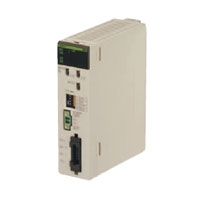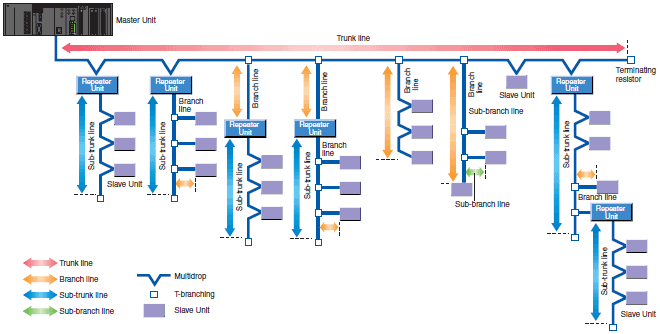| Item | Specification | |
| Communications protocol | CompoNet Network protocol | |
| Types of communications | Remote I/ communications ( communications as required with PLCs) |
|
| Baud rate | 4 Mbits/ |
|
| Modulation | Base- |
|
| Coding | Manchester code | |
| Error control | Manchester code rules, |
|
| Communications media | The following media can be used. Round cable I ( Round cable II ( Flat Cable I ( Flat Cable II ( |
|
| Communications distance
and wiring |
Refer to Cable Types, |
|
| Connectable Master Units | CompoNet Master Units | |
| Connectable Slave Units | CompoNet Slave Units | |
| Maximum I/ |
Word Slave Units: Bit Slave Units: |
|
| Maximum number of nodes | Word Slave Units: Bit Slave Units: Repeater Units: |
|
| Bits allocated per node
address |
Word Slave Units: Bit Slave Units: |
|
| Maximum number of nodes
per trunk line or sub- line |
32 nodes ( |
|
| Applicable node addresses | Word Slave Units: Bit Slave Units: Repeater Units: |
|
| Repeater Unit application
conditions |
Up to 64 Repeater Units can be connected per network. from the Master Unit, allowed between a Slave Unit and the Master Unit) |
|
| Signal lines | Two lines: |
|
| Power lines | Two lines: Power is supplied from the Master Unit or Repeater Units. |
|
| Communications power
supply |
24 VDC ± 10% |
|
| Connection forms | Flat Cable at baud rate of 93. Other cables or baud rates: |
|
| Connections for Slave Units and Repeater Units: |
||
| Remote I/ communications |
Automatic startup when power is turned ON * Start Switch in I/ In Registered Slave Unit Participation Standby Mode, Slave Units are participating in the network. In Communications Error Communications Stop Mode, error occurs. |
|
| I/ manual startup mode |
I/ communications are not started when the power is turned ON. until the Remote I/ |
|
| Communications error
communications stop mode |
All remote I/ |
|
| Communications error
input data zero clear mode |
All input data will be cleared to zeros in any Slave Unit in which a communications error occurs. |
|
| Duplicated Slave address
check |
If the same address is set for two different Slave Units or the same memory is allocated to two different
nodes, the network. |
|
| Registration table | The Slave Units that can participate for each node address are registered in a table so that only the
registered Slave Units can participate. Registration Table Verification Error Flag will turn ON. or manually edited from the CompoNet Support Software. |
|
| Slave Unit
status |
Without
registration table |
Participation Flag and Communications Error Flag for each Slave Unit
Participation Flag: system power is turned ON. Communications Error Flag: reason after the Slave Unit has joined the network ( the error is removed. Duplicated Address Error Flags and Alarm Flags |
| With
registration table |
Participation Flags and Communications Error Flags for each node address for all Slave Units registered
in the Registration Table Registration Table Verification Error Flags All Registered Slave Units Participating Flag |
|




